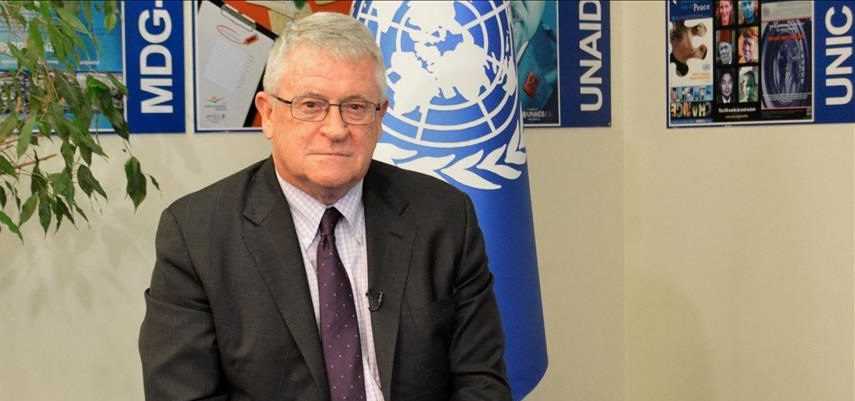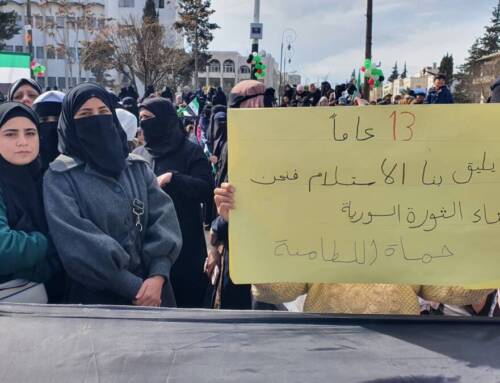UN Regional Humanitarian Coordinator for Syria Kevin Kennedy: Closing Bab al-Salameh ‘endangers the lives of children’
UN Regional Humanitarian Coordinator for the Syria Crisis, Kevin Kennedy, speaks with Syria Direct about the humanitarian situation in northwest Syria and the impact of the recent closure of Bab al-Salameh.
13 July 2020
UN Regional Humanitarian Coordinator for the Syria Crisis, Kevin Kennedy 07/03/2017 (Anadolu Agency)
On July 11, the UN security council voted to extend the UN’s authorization to deliver aid via the Bab al-Hawa border crossing for the next twelve months, while also shutting the Bab al-Salameh border crossing, restricting the UN to just one access point to truck aid into opposition-held Syria.
Such a move “puts [UN] workers at more risk … creates more complications and endangers the lives of children,” the UN Regional Humanitarian Coordinator for the Syria Crisis, Kevin Kennedy, told Syria Direct’s reporter Will Christou on July 9.
The UN operation in northwest Syria is “massive,” and to make aid delivery any more complex by shutting Bab al-Salameh, “impedes the operation to a great degree,” Kennedy explained. The alternative to using border crossings is to reroute international aid through Damascus to territories not under Syrian government control, such as northwest and northeast Syria. However, to do so you must first overcome “friction, hurdles,” according to Kennedy, making regular and sustained deliveries via Damascus difficult to imagine.
We spent last week talking to civil society members and humanitarian workers, both in Turkey and Syria, and they are very concerned about the short-term needs of civilians, pointing to shortages in goods like infant food. Can you tell us what is going to happen next? How is the UN going to help fulfill the needs of those civilians?
Numbers can be overwhelming in this crisis, but we have a couple of key figures. If we are to meet the needs of the four million people in northwest Syria, of whom currently 2.8 million are receiving assistance, we need cross-border access to that area. No question about it, it is the only way to meet those needs. Other modalities will not do the job. That is clear.
The current proposal from the Russian Federation has been for only one crossing [since this interview was conducted, this proposal was adopted by the UNSC], Bab al-Hawa, and to close off Bab al-Salam [also known as Bab al-Salameh], which would create a lot of difficulties for the operation.
First of all, it puts our workers at more risk, because then you have to cross conflict lines to deliver assistance. Now, when you cross Bab al-Hawa, you are basically in HTS [Hayat Tahrir al-Sham] country, and of course in Bab al-Salam, you are in Turkish [-controlled] areas so there is a security problem.
It also increases the complexity of this operation. Instead of driving 20 minutes, you drive two or three hours, increasing costs, turnaround time, etc. The NGOs and the UN run a massive operation in northwest Syria. It’s huge. I have been involved in many crises and this is the biggest operation; it reminds me of Darfur [in Sudan] in the early days. To add complexity, more logistics, more time, more money, more arrangements, and more coordination, it impedes the operation to a great degree.
In the Bab al-Salam area, we service about 1.8 million people, 800,000 [Internally Displaced Persons] IDPs and some of the densest IDP camps in that region. There are some 600 communities that rely on the assistance we deliver.
What is particularly acute, and I think is overlooked in these discussions, is the impact on health and on children, which is of course overlaid with the whole COVID-19 problem. When we deliver vaccines to that region, they are put in cold storage, which is a very fragile thing. It has to be handled carefully so the vaccines do not spoil. Currently, the WHO and UNICEF deliver vaccines across Bab al-Salam to the cold center in Azaz [in northern Aleppo], and then they are spread out to some 45 different [centers] where we give vaccines in Al-Bab, Azaz, Afrin and Jarabulus.
This is just one example, but I think it is telling, as losing this one access [point] creates more complications and in fact endangers the lives of children.
Several NGOs operating in Syria told Syria Direct that they were concerned that if aid was rerouted through Damascus there would be interference from the Syrian government—namely in siphoning off aid and forcing them to share beneficiary information with security services. In a world where more aid goes through Damascus, how would OCHA be able to protect aid and its beneficiaries?
We ran so-called crossline operations or tried to run them for years [from Damascus] to all the besieged and hard-to-reach areas in Syria. We achieved limited success, but could go months without a crossline convoy being authorized. Or we might get authorized at the last minute, and officials would take off the health and surgical supplies from the convoy.
Of course, an enormous chain of events is required for one convoy to happen. I recall that it was 13 different, separate steps to get a truck, put something on it, and get it from point A to point B. It became a second career every time these convoys went, and they became a big event in and of themselves.
Given the volume of operations in northwest Syria, the scale, the frequency—I do not see how that could ever be accomplished effectively, assuming that the situation on the ground stays the same, through crossline operations. We tried and we are going to try to do one in the near future, we hope, from the government to non-government [-held] areas. But it is tricky and of course, it requires a lot more coordination. It is also different now, because there are different sides and it is all seen, unfortunately, through a political lens. This is probably the most politicized crisis I have ever been involved in, from all sides.
We run crossline operations into northeast Syria and we have had some more success recently. But, to go crossline and actually get it to all the people that you need to get it to—in this case, INGOs not favored by the government in Damascus—that is not an easy task. When we had Yarubiyah [a Syria-Iraq border crossing near al-Hasakah], it was easy. Our trucks would come across, there was one simple depot, NGOs would come to pick up their stuff. We do not have that now in the northeast, so it becomes very confusing.
We are meeting some of the needs, but not all of the needs. To run these operations, you need something that is regular, reliable and safe. Crossline operations do not meet those criteria.
Besides the logistics, one of the complaints from civil society organizations was that the aid going through Damascus was being politicized, and in particular, people living in previously-opposition affiliated neighborhoods were being excluded from aid distribution. Do you feel the UN has sufficient leverage to resist that or should this just be viewed as an inevitable cost of distributing aid through Damascus?
The Syrian Arab Red Crescent [SARC] is our primary implementer inside Syria and in these areas in particular. In the past, during crossline operations in a place like Eastern Ghouta, the UN would deliver the assistance, but SARC was the distributor of the assistance.
I would say that we have actually had a good rapport with SARC over the years. They lost sixty or seventy [individuals] who were killed in this conflict. It is not like they are sitting in the back row someplace.
There is also a variety of different monitoring [mechanisms]. I know in the northwest we do a lot to make sure the [aid] gets to where it is supposed to go. We hire people who do nothing but monitor and take pictures of aid being distributed. It has become pretty sophisticated monitoring. It is still not as good as being on the scene, which is why it is important for the UN to access northwest Syria with our regular and international staff, and go in to see with our own eyes what is happening as best as one can.
Also, this may not be conclusive, but I was in this [same] post from January 2015 to June 2017 and now I am back. In the age of smartphones, where everyone has a camera, I have only seen one picture come out of Syria where someone said, “Hey, this stuff has been taken from the people it should go to.”
That may not be conclusive, we just do not have eyes on the ground, but I would have expected to receive more reports of aid diversion than we have received, and we have received very few reports of [aid diversion].
The Russian mission to the UN put out a statement on July 7 that mentioned a July 4 delivery from Damascus to Hasakah as proof that crossline delivery via Damascus can work. What do you think about this statement, is it evidence that crossline delivery can be effective?
That particular delivery I am very familiar with; it took six months to get there. It was a WHO delivery, 80.5 tons. These were the things that were loaded up to be delivered prior to the expiration of the resolution [in January 2020]. There were various negotiations to move them from Erbil on a Russian plane and fly them to Damascus, get all the facilitation letters and get them up to the northeast. It took from January to late June, basically six months.
I think this is indicative of the hurdles and the friction one faces when conducting crossline operations, when you want to have regular, sustained, reliable deliveries.
When these supplies arrive, they go across the line, some go to government-run hospitals, some go to hospitals run by the Self-Administration [the Autonomous Administration of North and East Syria]. Then, it is supposed to go to the 86 different health facilities run by international NGOs in northeastern Syria. Our best figure is that, on average, about 33 percent of these have been receiving supplies via the crossline apparatus. The rest [of the aid] does not get there, for all kinds of reasons. It worked to a point, but it is not what we need.
This interview reflects minor changes made for clarity on 19/07/2020 at 1:00 pm.







